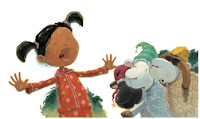Title: The Gruffalo
Julia Donaldson (Author)
Axel Scheffler (Illustrator)
Comprehension Strategies: Visualizing, Inferring
Arts Modalities: Visual Art, Drama
Summary:
A mouse is taking a stroll through the deep, dark wood when along comes a hungry fox, then an owl, and then a snake. The mouse is smart enough to know he would be a tasty treat, so he describes the gruffalo. Visualize the gruffalo: a creature with terrible claws, terrible tusks, terrible jaws, knobbly knees, turned-out toes, and a poisonous wart at the end of its nose. Wait. Could there really be such a thing as a gruffalo?
Materials:
The Gruffalo
chart with picture of gruffalo (covered for beginning of lesson)
paper
crayons or markers
character masks (optional)
character masks (optional)
Lesson:
Before you begin reading, show your class the spread of pages in the book that shows the setting.
Activate schema by asking questions such as:
“Have you ever been in the deep, dark wood?”
“What animals live in the forest?”
Discuss the words predator and prey.
Show the cover of the book with the picture of the gruffalo covered.
Explain that as you read the first half of the book, the students should listen for clues that help them visualize what a gruffalo might look like. Read aloud until the gruffalo makes his first appearance.
Have the class help you make a chart similar to the one shown that lists the physical characteristics of the gruffalo.
For added fun, play the song from the audio recording of the book. (Available at audible.com. Click the image to go to the recording.)
You can also listen to the song with this youtube link:
Now reveal the gruffalo on your chart and
Read the entire book from start to finish!
During another read aloud time, use the illustrations to have the children practice inferring. Show the students the picture of one of the animals as it approaches the mouse (remember that predator/prey relationship!). Compare to the picture of the animal after Mouse describes the gruffalo. What facial expressions change? How do the animals' movements change from showing confidence to fear? Invite the students to practice making these actions.
These masks are a hit when it comes to retelling and dramatizing the story. Of course, you can use them when leading students through a reenactment. To increase the thinking-skill level, ask a student to choose a character mask. Then interview the character to find out what it was thinking at different points in the story. Click the image to download the masks from Early Learning HQ.
 |
We went out to the "deep, dark wood!"
This wonderful site also contains finger puppets, word cards, posters and more!
Here's another video worth sharing to your young readers and and writers. Julia Donaldson shares her drafts of the book. Then she delights her audience by singing the gruffalo song with Gruffalo himself!


















































